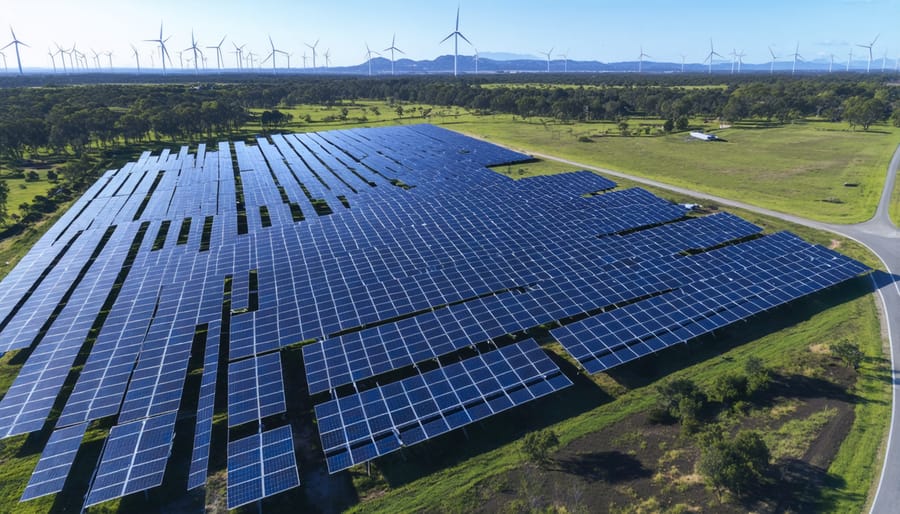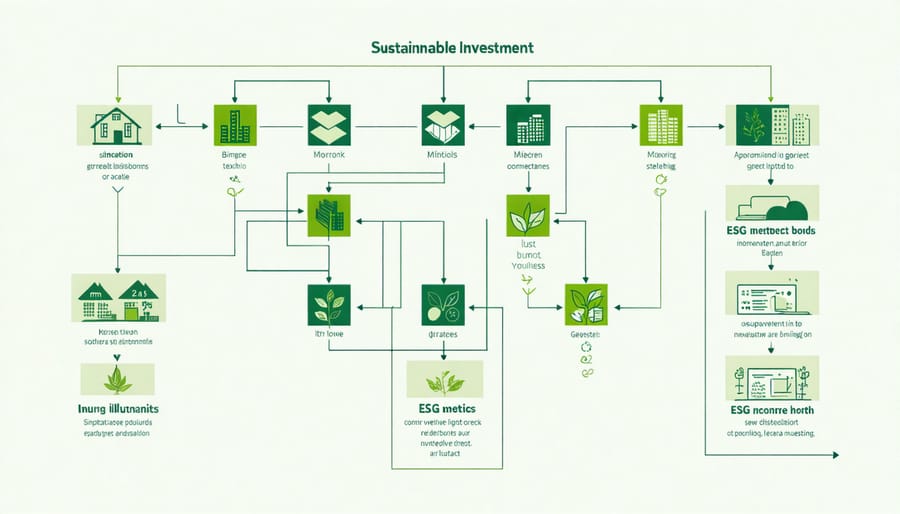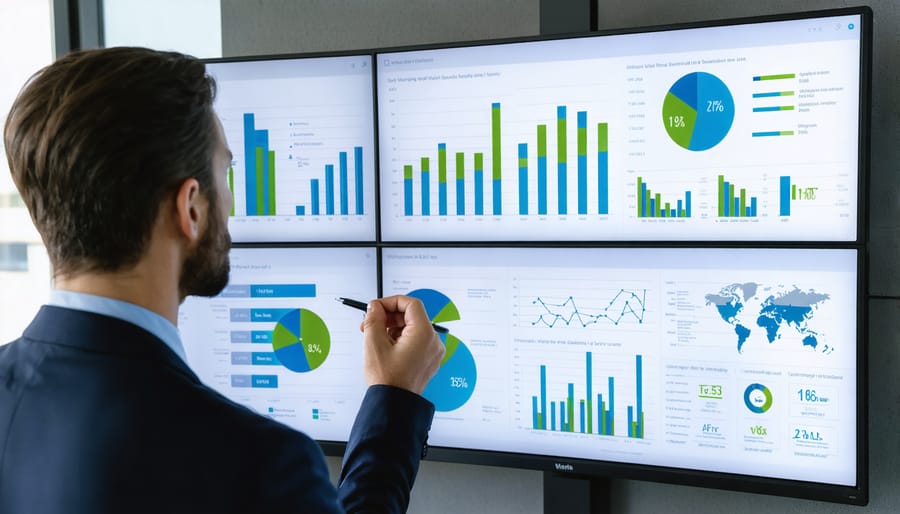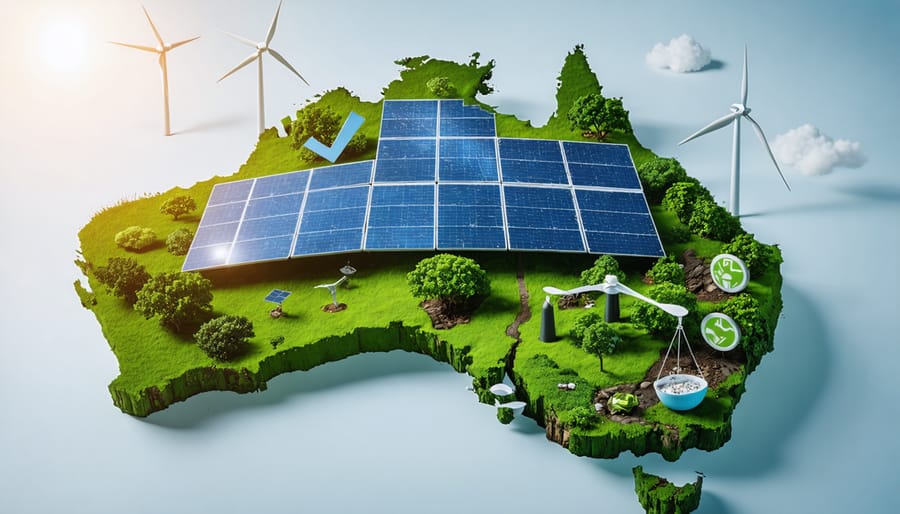Transform your investment portfolio by integrating circular economy principles with proven financial strategies. Screen potential investments using ESG metrics while maintaining a focus on market-beating returns. Target companies leading Australia’s renewable energy transition, particularly those with established revenue streams and scalable clean technology solutions. Allocate 20-30% of holdings to certified green bonds and sustainability-linked securities, which have demonstrated resilience during market volatility while supporting critical environmental projects.
The sustainable investment landscape has evolved beyond simple ethical screening, now offering sophisticated vehicles that capitalize on the global shift toward clean energy and resource efficiency. Australian investors are uniquely positioned to benefit from the nation’s abundant renewable resources and growing green technology sector, with opportunities in solar, wind, and bioenergy projects delivering both environmental impact and competitive financial returns.
Forward-thinking investors recognize that sustainability isn’t just about environmental responsibility—it’s about capturing the tremendous value created as entire industries restructure around climate solutions and resource efficiency. This strategic approach to sustainable investing helps shield portfolios from climate-related risks while positioning them to capture the upside of the green economic transition.
The Green Investment Revolution in Australia

Current Market Trends and Growth Potential
The sustainable investment market in Australia has witnessed remarkable growth, with the total value of sustainable investments reaching $1.2 trillion in 2022, representing a 30% increase from the previous year. This surge reflects a broader global trend where environmental, social, and governance (ESG) considerations are becoming central to investment decisions.
Australian investors are increasingly gravitating towards renewable energy projects, particularly in solar and wind power, which have shown consistent returns averaging 8-12% annually. The bioenergy sector has emerged as a particularly promising area, with projections suggesting a compound annual growth rate of 15% over the next five years.
Institutional investors, including superannuation funds, are leading this shift, with many committing to net-zero targets by 2050. This institutional backing has created a robust foundation for sustainable investments, making them more accessible to retail investors through various investment vehicles such as managed funds and ETFs.
The market is further bolstered by supportive government policies and growing consumer demand for sustainable products and services. Industry analysts predict that sustainable investments could represent up to 60% of all managed assets in Australia by 2025, indicating significant growth potential for investors entering this space.
Key Drivers Behind Sustainable Investments
The momentum behind sustainable investments is being driven by three powerful forces reshaping our financial landscape. Environmental concerns, particularly climate change and resource depletion, have become impossible to ignore, pushing investors to seek out companies committed to sustainable business practices and environmental stewardship.
Social factors are equally compelling, with growing consumer awareness and demand for ethical business practices. Australian investors, especially younger generations, are increasingly aligning their portfolios with their values, supporting companies that prioritize fair labor practices, community engagement, and social responsibility.
The regulatory landscape is evolving rapidly, with governments worldwide implementing stricter environmental standards and disclosure requirements. In Australia, initiatives like the Modern Slavery Act and enhanced ESG reporting guidelines are creating a more transparent and accountable investment environment.
Market data consistently shows that companies embracing sustainability often outperform their peers, challenging the outdated notion that ethical investing means sacrificing returns. This performance advantage, combined with rising environmental awareness and regulatory pressure, has created a perfect storm propelling sustainable investments into the mainstream of financial markets.
Profitable Pathways in Sustainable Investments

Green Bonds and Climate-Aligned Securities
Green bonds and climate-aligned securities have emerged as powerful tools for investors looking to make a positive environmental impact while earning steady returns. These fixed-income instruments specifically fund projects that address climate change, renewable energy development, and environmental conservation.
In Australia, the green bond market has experienced remarkable growth, with major banks and corporations increasingly issuing these securities to finance sustainable initiatives. The Clean Energy Finance Corporation (CEFC) has been particularly active in this space, supporting various green bond issuances that fund everything from wind farms in Victoria to solar installations in Queensland.
These investments typically offer yields comparable to traditional bonds while providing the added benefit of environmental stewardship. For example, the Australian Corporate Green Bond Index has demonstrated consistent performance, often matching or outperforming conventional corporate bond indices.
Climate-aligned securities extend beyond traditional green bonds to include sustainability-linked bonds, where interest rates are tied to the issuer’s achievement of specific environmental targets. This innovative approach has gained traction among Australian investors who want to encourage corporate accountability while maintaining their investment returns.
For those new to sustainable fixed-income investing, certified green bonds offer a straightforward entry point. These bonds undergo rigorous third-party verification to ensure they genuinely support environmental projects, providing investors with confidence in their impact. Many superannuation funds now include green bonds as part of their sustainable investment options, making them accessible to everyday Australians.
Renewable Energy Infrastructure Projects
Direct investment in renewable energy infrastructure presents compelling opportunities for investors seeking both environmental impact and financial returns. Australia’s vast renewable resources and supportive policy framework make it an ideal market for sustainable infrastructure projects, particularly in the bioenergy sector.
Bioenergy facilities, which convert organic waste into clean energy, represent a growing investment opportunity. These projects typically offer stable, long-term returns through power purchase agreements and waste management contracts. For example, the Western Sydney Bioenergy Facility demonstrates how green business transformation can create multiple revenue streams while addressing waste management challenges.
Solar and wind infrastructure projects continue to attract significant investment, with utility-scale developments offering attractive returns through government incentives and increasing corporate demand for renewable energy. The emergence of battery storage projects has created additional investment opportunities, helping to address intermittency issues and enhance grid stability.
Investment vehicles range from direct project ownership to infrastructure funds specializing in renewable assets. Many superannuation funds now offer renewable infrastructure options, making these investments accessible to everyday Australians. Community energy projects are also gaining traction, allowing local investors to participate in smaller-scale renewable developments while supporting regional energy independence.
Success stories like the Port Augusta Renewable Energy Park showcase how infrastructure investments can deliver both environmental benefits and solid financial performance, while contributing to Australia’s clean energy future.
ESG-Focused Investment Funds
ESG-focused investment funds have emerged as powerful vehicles for investors seeking to align their portfolios with sustainable values while maintaining competitive returns. In Australia, these funds have seen remarkable growth, with major providers like Australian Ethical and Pendal offering diversified options that screen investments based on environmental, social, and governance criteria.
Exchange-traded funds (ETFs) have become particularly popular, offering investors easy access to sustainability-focused portfolios. Notable examples include the BetaShares Climate Change Innovation ETF and the VanEck MSCI Australian Sustainable Equity ETF, which focus on companies leading the charge in renewable energy, sustainable agriculture, and clean technology.
These funds employ various screening methods to ensure portfolio companies meet strict sustainability criteria. Positive screening identifies companies making significant contributions to environmental solutions, while negative screening excludes businesses involved in fossil fuels, deforestation, or poor labour practices.
Performance data shows that many ESG funds have matched or outperformed traditional investments, challenging the misconception that sustainable investing requires sacrificing returns. For instance, several Australian sustainable funds have delivered average annual returns exceeding 10% over the past five years.
For investors new to sustainable investing, managed funds offer professional expertise and instant diversification. Many providers now offer low minimum investment amounts, making sustainable investing accessible to more Australians. Regular contribution plans allow investors to build their sustainable portfolios gradually while benefiting from dollar-cost averaging.
Risk Management in Sustainable Investing
Due Diligence Framework
A robust due diligence framework is essential for making informed sustainable investment decisions. Start by examining an investment’s environmental impact metrics, including carbon emissions, waste management practices, and resource efficiency. Look for companies that not only report these metrics transparently but also show consistent improvement over time.
Financial viability remains crucial – assess traditional metrics like revenue growth, profit margins, and market position alongside sustainability credentials. Companies with strong environmental practices often demonstrate better risk management and long-term resilience.
Consider the regulatory landscape and compliance history. In Australia, familiarise yourself with frameworks like the National Greenhouse and Energy Reporting scheme and ensure potential investments align with these requirements. Pay attention to upcoming environmental regulations that could affect future performance.
Evaluate the management team’s commitment to sustainability. Look for clear environmental policies, dedicated sustainability officers, and regular reporting on environmental goals. The best opportunities often come from organisations where sustainability is embedded in corporate culture rather than treated as an afterthought.
Investigate supply chain sustainability and stakeholder relationships. Companies should demonstrate responsible sourcing practices and positive engagement with local communities. This is particularly important in sectors like renewable energy, where community support can make or break projects.
Finally, verify any green certifications or sustainability ratings from recognised bodies. While these shouldn’t be the sole decision factor, they provide valuable third-party validation of environmental claims.
Performance Monitoring and Impact Measurement
Effective performance monitoring in sustainable investments requires a dual focus on financial returns and environmental impact metrics. Leading Australian investment firms now employ sophisticated tracking systems that measure both traditional financial indicators and sustainability outcomes, providing investors with a comprehensive view of their portfolio’s performance.
Key financial metrics include risk-adjusted returns, volatility measures, and benchmark comparisons against conventional investments. These are complemented by sustainability indicators such as carbon emissions avoided, renewable energy generated, and water conservation achievements. Many Australian super funds have pioneered the use of impact scorecards that translate environmental benefits into easily understood metrics.
Real-time monitoring tools have become increasingly accessible, allowing investors to track their portfolio’s sustainability performance through user-friendly dashboards. These platforms often integrate data from multiple sources, including company sustainability reports, third-party environmental assessments, and regulatory compliance records.
Regular impact reporting has become standard practice, with quarterly or annual reports detailing both financial performance and environmental achievements. This transparency helps investors understand how their investments contribute to sustainability goals while maintaining competitive returns. Leading Australian investment managers have reported that portfolios with strong environmental credentials often demonstrate greater resilience during market volatility.
To ensure accuracy and credibility, many firms now engage independent auditors to verify both financial returns and environmental impact claims, providing investors with additional confidence in their sustainable investment choices.

Success Stories and Future Outlook
Australia’s sustainable investment landscape has witnessed remarkable success stories that demonstrate the viability of sustainable business models. Take Neoen’s Hornsdale Power Reserve in South Australia, which pairs wind energy with the world’s largest lithium-ion battery. This pioneering project has not only generated substantial returns for investors but has also saved consumers over $150 million in grid stabilization costs since its launch.
Another compelling example is the Clean Energy Finance Corporation’s (CEFC) investment in sustainable agriculture. Their backing of carbon-neutral beef producer Wilmot Cattle Company showcased how sustainable farming practices can deliver both environmental benefits and strong financial returns, with productivity increases of up to 20% reported in the first three years.
Looking ahead, Australia’s sustainable investment market is poised for explosive growth. Industry experts project that environmental, social, and governance (ESG) investments will triple by 2025, driven by increasing corporate commitments to net-zero targets and growing consumer demand for sustainable products and services.
The future outlook is particularly bright for renewable energy projects, with analysts forecasting that Australia could become a renewable energy superpower by 2030. Major investment opportunities are emerging in green hydrogen production, with projects like the Asian Renewable Energy Hub in Western Australia attracting international attention and investment.
The implementation of new sustainability reporting requirements and the establishment of green investment standards are expected to further boost investor confidence. Additionally, the rise of innovative financing mechanisms, such as green bonds and sustainability-linked loans, is creating new pathways for investors to participate in Australia’s sustainable future.
These success stories and positive market indicators suggest that sustainable investments are not just environmentally responsible choices but increasingly profitable ones. As Australia continues its transition to a low-carbon economy, early adopters of sustainable investment strategies are well-positioned to capture significant market opportunities while contributing to positive environmental outcomes.
The journey toward sustainable investing is not just about securing our financial future – it’s about shaping a better world for generations to come. Throughout this exploration of sustainable investment strategies, we’ve seen how environmental, social, and governance (ESG) considerations can drive both positive change and competitive returns.
Australia stands at the forefront of this green investment revolution, with abundant opportunities in renewable energy, sustainable agriculture, and clean technology. The success stories we’ve shared demonstrate that sustainable investing is no longer a niche approach but a mainstream strategy for forward-thinking investors.
As we’ve discovered, the key to successful sustainable investing lies in careful research, diversification, and alignment with your values. Whether you’re considering green bonds, ESG-focused ETFs, or direct investments in renewable energy projects, there’s a sustainable investment pathway suited to every investor’s goals and risk tolerance.
The time to act is now. Start by reviewing your current portfolio through a sustainability lens. Consider speaking with a financial advisor who specialises in ESG investments, and explore the growing number of sustainable investment products available in the Australian market. Even small steps, such as allocating a portion of your portfolio to renewable energy funds, can make a meaningful impact.
Remember, sustainable investing isn’t just about avoiding harmful industries – it’s about actively supporting innovations and companies that are building a cleaner, more equitable future. By choosing to invest sustainably, you’re not only protecting your financial interests but contributing to Australia’s transition to a low-carbon economy.

